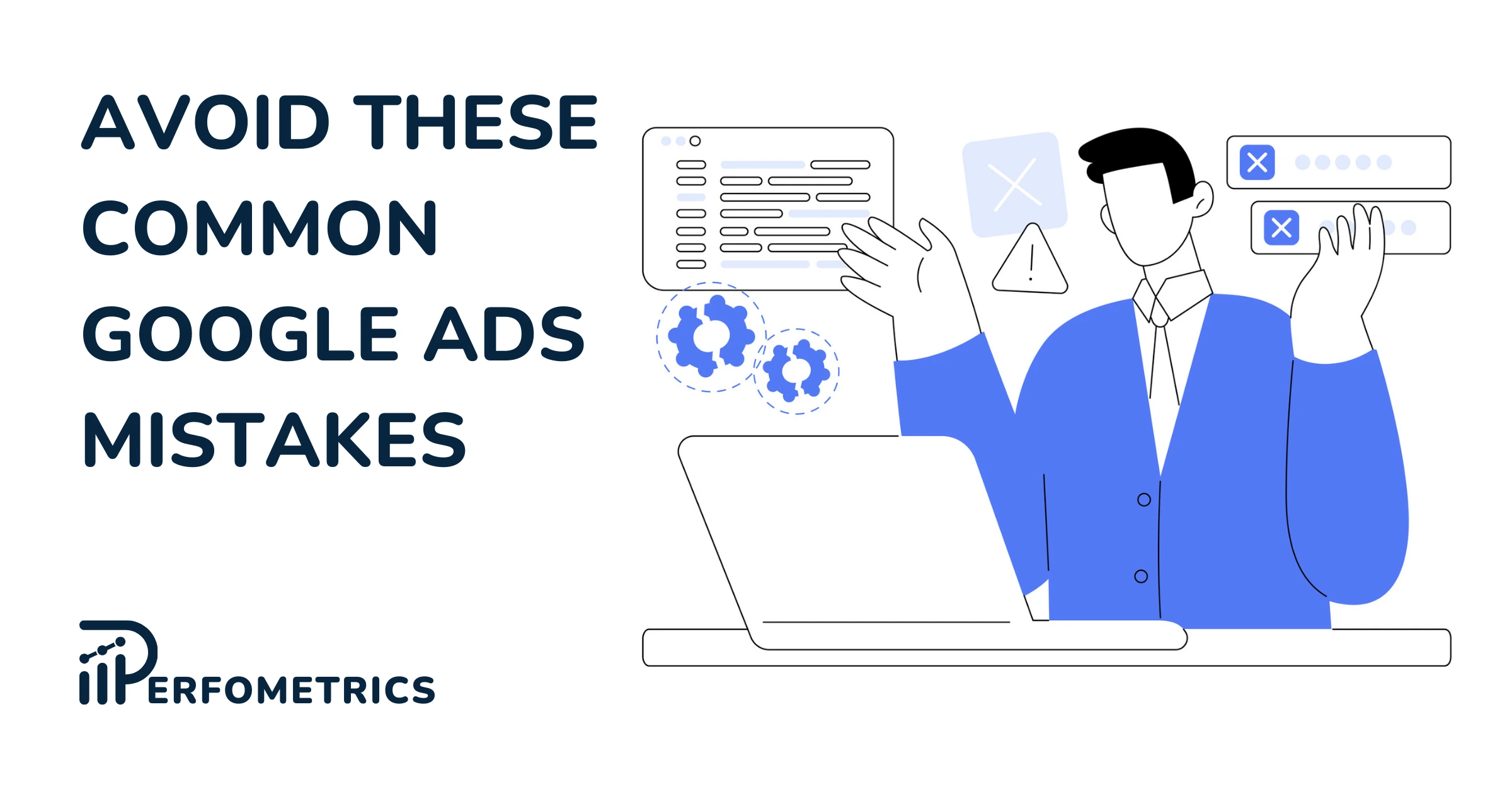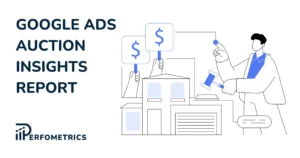10 Common Mistakes in Google Ads to Avoid in 2024

To succeed with Google Ads, avoiding common pitfalls is as important as executing a great strategy. With this complete blog post, we will take you through the 10 most common Google Ads mistakes to avoid to ensure you’re not unintentionally hampering your campaigns. We’ll also help you learn how to spot and correct these errors before they impact your campaign performance, and more importantly your ad spend.
Key Takeaways
- Set clear goals and define a structured strategy for your Google Ads campaigns.
- Organize your campaigns effectively to track performance and make informed decisions.
- Target your ads carefully to reach relevant users and maximize your ROI.
- Track conversions to measure the effectiveness of your campaigns and identify areas for improvement.
- Select the appropriate campaign type for your specific goals and objectives.
- Optimize your bidding strategies to control costs and maximize conversions.
- Create compelling and relevant landing pages that drive users to take desired actions.
- Craft engaging and persuasive ad copy that captures attention and promotes your products or services.
- Regularly review and analyze campaign performance to identify underperforming elements and make necessary adjustments.
- Base your campaign decisions on data-driven insights rather than assumptions.
Mistake #1: Not Having Clear Goals and Strategy
Lack of clear goals can lead to wasted ad spend, poor campaign performance, and missed opportunities. Without a clear vision for what you want to achieve, you’ll struggle to evaluate the effectiveness of your campaigns and make the necessary adjustments to improve results.
Nailing down your goals and strategy is the cornerstone of any successful marketing campaign, including Google Ads. Without clear goals and a well-defined strategy, it’s like embarking on a journey without a destination.
To avoid this mistake, take some time to define specific, measurable, achievable, relevant, and time-bound (SMART) goals for your Google Ads campaigns. For instance, you might aim to increase website traffic by 20% within the next quarter or generate 100 leads per month.
Here are some additional tips for setting clear goals:
- Align your goals with your overall marketing objectives.
- Consider your target audience and their needs.
- Break down your goals into smaller, achievable steps.
- Track your progress regularly and make adjustments as needed.
💡 For more, read: how to create a successful Google Ads campaign.
Mistake #2: Poor Campaign Structure
A well-structured Google Ads account is the foundation for effective campaign management and optimization. A haphazard campaign structure, on the other hand, can lead to confusion, wasted ad spending, and subpar performance.

Without a structured approach, your Google Ads campaigns can become a mess quite quickly, with keywords scattered across multiple campaigns, irrelevant ad groups, and duplicate ad copy. This disorganization can make it challenging to track performance, identify areas for improvement, and make informed decisions about optimizations.
Here are a few solutions for creating a proper campaign structure:
- Create separate campaigns for different products or services
- Use ad groups to group related keywords/audiences
- Create relevant ad copy
- Avoid duplicate keywords
- Use campaign names that reflect your objectives.
- Group keywords based on their intent and relevance to your products or services.
By adopting a structured approach to your Google Ads campaigns, you’ll gain better control over your ad spend, improve targeting accuracy, and maximize the effectiveness of your campaigns.
Mistake #3: Choosing The Wrong Targeting
Effective targeting is crucial for ensuring that your Google Ads are reaching the right audience for your products or services. Mistargeting can lead to wasted ad spend, a poor return on investment (ROI), and missed opportunities.
When targeting your Google Ads, it’s essential to consider the intent and demographics of your ideal customers. Mistargeting can result in your ads being displayed to individuals who are not interested in what you offer, leading to clicks from unqualified leads and ultimately, wasted ad spend.
Ineffective targeting can seriously hinder the performance of your Google Ads campaigns. By showing your ads to individuals who are unlikely to convert, you’re essentially throwing money away and limiting your chances of achieving your marketing goals.
Carefully consider the following elements when choosing your targeting:
- Keywords: Use relevant keywords that accurately reflect the products or services you offer. Avoid broad match keywords that may trigger your ads for irrelevant searches.
- Locations: Target specific locations where your target audience is most likely to be found. Consider factors like population density, demographics, and local competition.
- Audience Targeting: Leverage Google’s audience targeting options to reach users based on their interests, demographics, and online behavior.
- Negative Keywords: Identify and add negative keywords to your campaigns to prevent your ads from showing for irrelevant searches. This can help ensure that your ad spend is focused on high-quality leads.
💡 For more, read: creating a successful Google Ads campaign.
By carefully targeting your Google Ads to the right audience, you’ll increase your chances of reaching qualified leads, improving your ROI, and achieving your marketing goals.
Mistake #4: Not Tracking Conversions
Tracking conversions is essential for understanding the effectiveness of your Google Ads campaigns and identifying areas for improvement.
Inadequate conversion tracking can hinder your ability to optimize your campaigns, leading to wasted ad spend and poor return on investment (ROI). Without insights into which keywords, ad groups, and campaigns are driving conversions, you’ll struggle to make informed decisions about allocating your budget effectively.
To avoid this pitfall, implement Google Ads conversion tracking to monitor the actions you want users to take after clicking on your ads, such as making a purchase, signing up for a newsletter, or downloading a whitepaper.
💡 For more, read: how to implement conversion tracking in Google Ads.
By implementing thorough conversion tracking, you’ll gain valuable insights into the effectiveness of your Google Ads campaigns, allowing you to make informed decisions that maximize your ROI.
Mistake #5: Running The Wrong Campaign Type
Google Ads offers a variety of campaign types, each with its own strengths and weaknesses. Using the wrong campaign type can limit your reach and hinder your ability to achieve your goals.
Choosing the wrong campaign type can severly impact your ability to reach your target audience effectively, leading to wasted ad spend and a poor return on investment (ROI).
Carefully consider your marketing goals and target audience when selecting a campaign type.
💡 For more, read: every Google Ads campaign type.
By selecting the right campaign type for your specific goals, you’ll maximize your reach, improve your targeting accuracy, and achieve your marketing objectives more effectively.
Mistake #6: Using Ineffective Bidding Strategies
Choosing the wrong bidding strategy can lead to overpaying for clicks, driving up your ad spend without a corresponding increase in conversions. Ineffective bidding strategies can also prevent your ads from showing when it matters most, limiting your reach and potential conversions.
It’s important to carefully consider your bidding strategy based on your campaign goals and targeting.
💡 For more, read: different bidding strategies in Google Ads explained.
By selecting the most appropriate bidding strategy for your specific goals, you’ll optimize your ad spend, improve your conversion rates, and achieve better results from your Google Ads campaigns.
Mistake #7: Using Irrelevant Landing Pages
When users click on your ad, they expect to be taken to a page that is relevant to their search query and provides the information they’re looking for.
If the landing page is irrelevant or confusing, users will likely bounce back to the search results page, wasting your ad spend and potentially damaging your brand reputation. This can significantly reduce your conversion rates and undermine your Google Ads campaigns.
💡 For more, read: best practices when creating Google Ads landing pages.
By creating relevant and engaging landing pages, you’ll increase the likelihood of converting clicks into conversions, improving the overall effectiveness of your Google Ads campaigns.
Mistake #8: Displaying Poorly Made Ads
Your ads are the first impression you make on potential customers, so poorly crafted ads will not capture attention or encourage clicks.
When users see your ad, they have a split second to decide if it’s worth their time to click. If your ad is poorly designed or written, they’ll likely scroll past it without a second thought.
Pitiful ads can significantly hinder your ability to attract clicks and conversions. By failing to capture attention and engage users, you’re essentially squandering valuable ad space and wasting your marketing budget.
To avoid this pitfall, ensure that your ads are:
- Compelling: Use strong visuals and clear, concise messaging that grabs attention and communicates your message effectively.
- Targeted: Tailor your ad copy and visuals to resonate with your target audience and address their specific needs and interests.
- Action-oriented: Include clear and prominent call-to-action buttons that encourage users to take the desired action, such as making a purchase, signing up for a newsletter, or downloading a whitepaper.
- Mobile-friendly: Ensure that your ads are optimized for mobile devices, as a significant portion of traffic comes from smartphones and tablets.
- A/B test: Experiment with different ad variations to identify the most effective combinations of visuals and messaging for your target audience.
💡 For more, read: improve ads with Google Ads asset report.
By creating compelling ads, you’ll increase the likelihood of capturing attention, encouraging clicks, and ultimately achieving your marketing goals.
Mistake #9: Lack of Analysis & Optimization Routine
Regularly analyzing and optimizing your Google Ads campaigns is essential for maintaining their effectiveness and achieving your marketing goals.
Neglecting to monitor your campaigns can lead to stagnation and missed opportunities. Without ongoing analysis and optimization plan, you’ll have limited visibility into areas for improvement and may not be able to react to changes in search behavior or market trends.
Make sure to establish a regular routine for analyzing and optimizing your campaigns. This should involve:
- Regularly review campaign performance: Track key metrics such as impressions, clicks, conversion rates, and average cost-per-click (CPC).
- Identify underperforming elements: Analyze which keywords, ad groups, and campaigns are performing below expectations.
- Make adjustments to improve performance: Implement changes to bidding strategies, ad copy, landing pages, or targeting settings.
- Test and iterate: Continuously experiment with different strategies and tactics to optimize your campaigns for maximum effectiveness.
💡 For more, read: Google Ads optimization score.
By establishing a structured analysis and optimization routine, you’ll ensure that your Google Ads campaigns are continuously improving and delivering the results you want.
Mistake #10: Not Making Data-Driven Decisions
Data-driven decision-making is crucial for optimizing your Google Ads campaigns and achieving your marketing objectives.
Relying on guesswork or personal opinions when making campaign decisions can lead to ineffective strategies and wasted ad spend. Without data-driven insights, you’ll struggle to identify opportunities for improvement and make informed decisions that align with your campaign goals.
💡 For more, read: effectively using columns and segments in Google Ads.
By basing your decisions on data rather than assumptions, you’ll gain a clearer understanding of your campaign performance, optimize your strategies, and achieve better results.
Final Word
Especially when first starting out, some simple mistakes can be made. We hope this blog post was useful and helps you avoiding these 10 common Google Ads mistakes. This should ensure the effectiveness of your campaigns and achieve your marketing goals.



